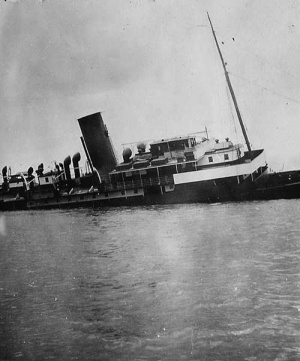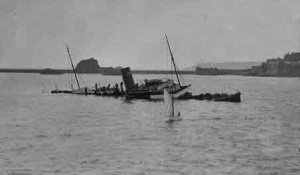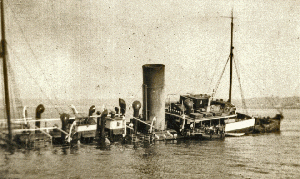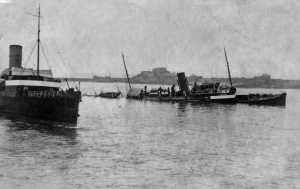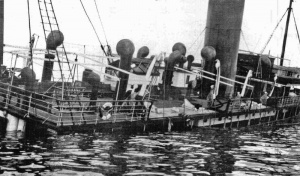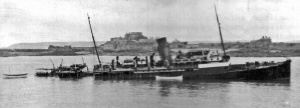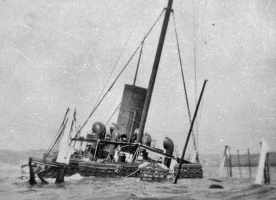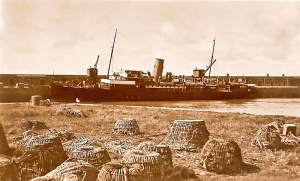Caesarea, 1923

Shipwreck: ss Caesarea
|
On 7 July 1923 the mailboat Caesarea struck a rock off Noirmont on her way out from the island. She was able to turn round and almost made it back to St Helier Harbour, but sank just outside the pierheads.
She had 373 passengers and 61 crew on board, and a cargo of vegetables, flowers and mail, and hit the rocks in thick fog. Water began to enter the stokehold and engine room and the stern was deep in the water, with lifeboats trailing behind as she approached St Helier Harbour. She stuck fast but was refloated on 20 July on a spring tide. Nobody was injured.
Vessel's history
The Caesarea (Official No 131763) was a steel-hulled 1,505 ton passenger ship that was completed as yard No 761 in September 1910 by Cammell, Laird and Co, Birkenhead. She was launched on 26 May 1910 for London and South Western Railway Company, Southampton. She measured 284 ft 6in x 39 ft 1in and was powered by three steam turbines.
From October 1914 to December 1915 she was an Admiralty requisition - armed boarding steamer. In 1923 the registered owner was Southern Railway, Southampton.
She did not return to Jersey after being taken to England for repairs following the shipwreck because she was sold and renamed Manx Maid by the Isle of Man Steam Packet Company.
From October 1941 to 1945 she was an Admiralty requisition - radar training ship HMS Bruce. She was finally broken up at Barrow in 1950 by T W Ward.

Newspaper reports
A look back at contemporaneous newspaper reports from a Jersey Evening Post article in 2018
Many passengers were unaware that the Caesarea was sinking as she limped back towards St Helier Harbour just minutes after departing. Some had felt a small bump as the ship struck rocks, while others reported noticing the vessel shiver as she passed near Noirmont Point in thick fog en route to Guernsey and Southampton.
But many had felt nothing, and one traveller was so oblivious to the danger the ship was in that when the fog temporarily lifted and the pierheads of St Helier Harbour came into sight, she remarked:'Is this Guernsey already?'
The sea was calm but the visibility was poor, and conditions were similar to those 12 years earlier when the Roebuck famously crashed into the Kaines rocks off St Brelade's Bay.
People had gathered at the Harbour for the arrival of the Alberta passenger ship from Southampton, when a 'peculiar noise was heard from a steamer's siren'.
It was first thought that this was from a vessel waiting in the bay to enter when the fog lifted, but a few minutes later a startling rumour was circulating that something had happened to the Caesarea.
The speculation ended when the battered Caesarea appeared from out of the fog heading straight back to the Harbour she had left minutes earlier. Her stern was deep in the water and her lifeboats trailed over the side.
Stern stuck fast
- "The Caesarea came on slowly and it was first thought that she would make it to the harbour, but she had hardly passed the usual point at which the bow is turned for the pierheads than her stern stuck fast," the Evening Post reported.
It transpired that the ship had struck the Grand Four ledge near Noirmont Point. The impact ripped a huge gash along the ship's port side and tore out she port propeller. Captain E T Smith issued a distress call and turned his ship back towards St Helier.
Water poured in and Caesarea began to lose much of its power, making it harder for Captain Smith to control the vessel. For a while it appeared as though she would make it back to port, but as the crew struggled to bring the ship into line, she struck the Oyster Rock near the Harbour, leaving her with a huge hole in the other side.
Despite the extensive damage to both sides, and with water flooding into her boilers, the ship continued to inch towards the Harbour before hitting a sandbank and dropping on to her starboard side.
As was the case with many other shipping disasters around the Channel Islands at the time, the passengers remained calm as they were brought ashore.
- "The crew and steward's staff of the Caesarea worked like trojans and the total absence of any alarm was largely due to them," reported the Evening Post.
Alberta helps passengers
The Alberta took hundreds of the Caesarea's passengers on to Guernsey and Southampton. About 40 passengers decided to stay on dry land.
The Evening Post reported that as the Alberta passed through the pierhead, the Caesarea passengers on board shouted in unison 'Are we downhearted?' to those on the quay. 'No' was the resounding response.
Some of the cargo, including several bags of mail, were recovered from the wreck and some letters were sent on with the inscription 'Damaged by immersion in sea water before arrival at Jersey'.
The Caesarea lay partially submerged for a couple of weeks as attempts to refloat her repeatedly failed. On the night of 20 July, with a huge crowd looking on, the ship was eventually moved and on 3 August she was towed to dry dock in Southampton, never to return to Jersey.
The ship's lost propeller was found wedged between rocks off Noirmont Point by diver Tony Titterington in 1973 and is now on display outside the Maritime Museum.
Wrecked between the pierheads and Elizabeth Castle
